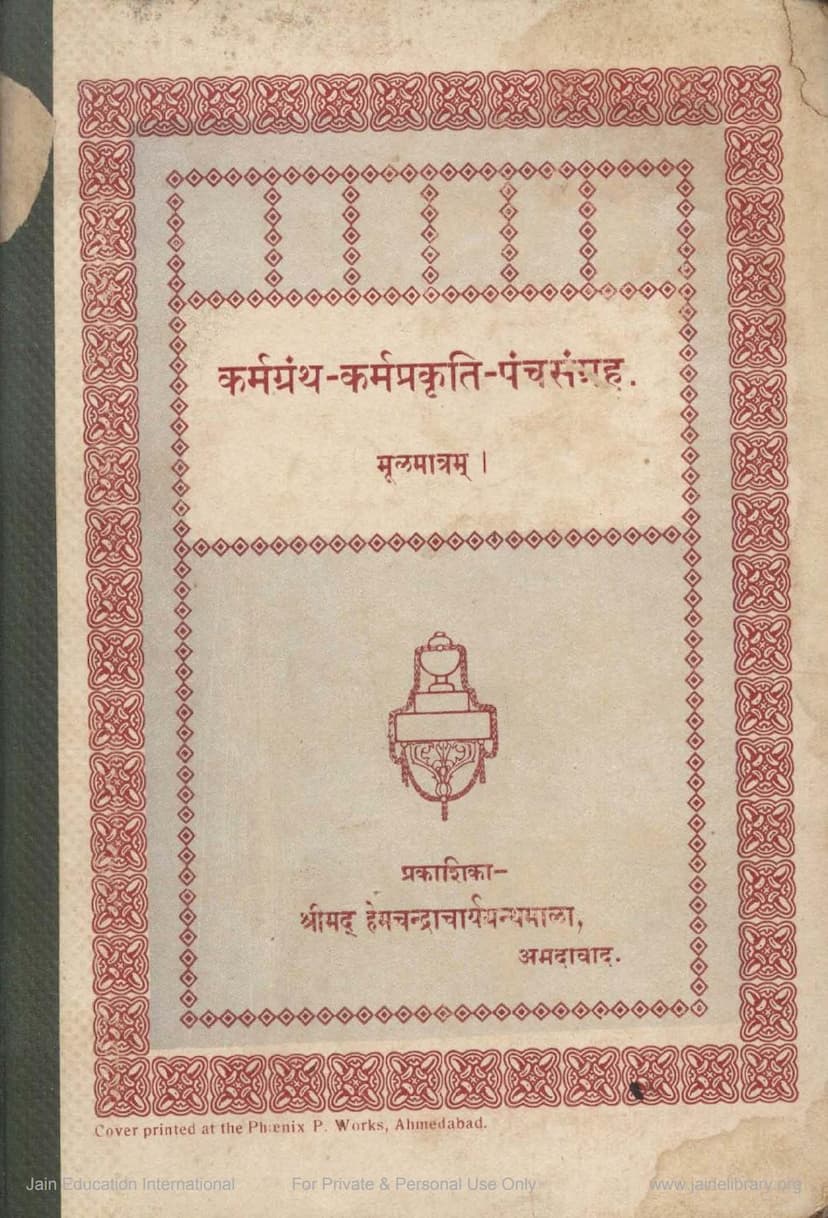Karmagrantha Karmaprakruti Panchasangraha
Added to library: September 2, 2025

Summary
This Jain text, titled "Karmagrantha Karmaprakruti Panchasangraha" (कर्मग्रंथ-कर्मप्रकृति-पंचसंग्रह), is a compilation of five important Jain treatises on the doctrine of Karma, compiled under the auspices of the Hemchandracharya Granthamala in Ahmedabad. The work is presented as a collection of foundational texts for understanding Jain cosmology and spiritual progression.
The text is presented in Gujarati and Prakrit/Apabhramsa, with the Prakrit sections forming the core doctrinal explanations. The preface indicates that this compilation was undertaken as per the instructions of Acharya Shri Vijaynitisuriji and is published in memory of Seth Sankalchand Chunilal, son of Seth Chunilal Gokaldas.
The five major sections (referred to as "Karma Granthas" or "Karmaprakrutis") within this compilation are:
-
Karma Vipaka Nama (कर्मविपाकनामा): Authored by Shri Devendra Suri. This section is the first and perhaps most extensive, detailing the vipaka (consequences or fruition) of different types of karmas. It systematically breaks down the 8 primary karmas (Naranayanam: Jnanavarniya, Darshanavarniya, Vedaniya, Mohaniya, Ayushya, Nama, Gotra, and Antaraya) into their numerous sub-categories (prakrutis) and explains their effects.
- Jnanavarniya (Knowledge-obscuring karma): Discusses the five types of knowledge (Mati, Shruta, Avadhi, Manahparyaya, Kevala) and their obscuring karmas.
- Darshanavarniya (Perception-obscuring karma): Details the types of perception (Chakshu, Achakshu, Avadhi, Kevala) and their obscuring karmas, including categories like Nidra and Prachala.
- Vedaniya (Feeling karma): Explains the pleasant (Sukha) and unpleasant (Duḥkha) experiences arising from karma, comparing them to the sharpness of a sword or the sting of honey.
- Mohaniya (Delusion karma): This is a crucial section, dividing into Darshan Mohaniya (perception delusion) and Charitra Mohaniya (conduct delusion).
- Darshan Mohaniya is further classified into Mithyatva (wrong belief), Samyaktva (right belief), and Mishra (mixed belief), with sub-categories based on purity.
- Charitra Mohaniya covers passions (Kashayas) like anger, pride, deceit, and greed, and accessory passions (Nokashayas) like laughter, aversion, desire, sorrow, fear, and disgust. It elaborates on the different modes of binding and their specific effects.
- Ayushya (Life-span karma): Describes the four types of lifespans (Naraka, Tiryancha, Manushya, Deva) and the karmas that determine them.
- Nama (Name karma): This section is incredibly detailed, listing the 84, 84 sub-types and further subdivisions of Nama karma, covering physical attributes like body types, senses, limbs, complexion, smell, taste, touch, and even subtler qualities like Agurulaghu (lightness/heaviness) and Udghata (uplifting).
- Gotra (Status karma): Explains high and low status determination.
- Antaraya (Obstruction karma): Details the five types of obstructions: Dana (giving), Labha (gain), Bhoga (enjoyment), Upabhoga (repeated enjoyment), and Virya (energy).
-
Karma Stava (कर्मस्तव): This section appears to be a hymn or devotional praise of Virajina (the Tirthankara Mahavira) in the context of karma. It elaborates on how all karmas are shed at different stages of spiritual development (Gunathana) through binding, fruition, issuance, and potency. It frequently quantifies the number of karmic bonds and their mutations across different stages and states of existence.
-
Bandha Swamitva (बन्धस्वामित्व): This section focuses on the "ownership" or the specific conditions under which souls bind to different karmic types. It delves into the relationship between the soul's state, its actions, and the resulting karmic bondage, analyzing how various combinations of attributes (like senses, soul-states, passions, knowledge, etc.) influence which karmas are bound. It extensively lists the specific karmic types bound by souls in different states of existence (Gati), senses (Indriya), and spiritual stages (Guna Sthana).
-
Shadashitika (षडशीतिका): This section, likely titled "Shadashitika" (meaning eighty-six, possibly referring to a number of categories or counts discussed), further elaborates on the karmic process. It discusses the role of different soul states (Jiva Sthanas), the types of senses (Indriya), passions (Kashaya), subtle states (Bhava), and their impact on karmic bondage, fruition, issuance, and potency. It employs complex numerical and combinatorial analysis to explain the interactions and counts of these karmic aspects.
-
Shataka (शतक): The fifth section, "Shataka" (meaning a hundred, likely referring to a hundred major points or classifications), concludes the primary discussion. It reiterates key concepts related to karma, possibly summarizing or providing additional classifications of karmas, their bonding, fruition, and the conditions for their shedding. It seems to present a systematic overview of the karmic framework.
Overall Themes and Significance:
- Detailed Karmic Analysis: The text provides an exceptionally detailed and systematic classification of karmas, breaking down the broad categories into specific manifestations and their effects.
- Quantitative Approach: The authors employ a highly quantitative method, often citing numbers of karmic sub-types, their durations, and the permutations of conditions that lead to karmic bondage and liberation.
- Foundation of Jain Philosophy: This work is a testament to the intellectual rigor of Jain philosophical inquiry, particularly in its meticulous treatment of karma, which is central to understanding the Jain path to liberation.
- Devotional Aspect: While primarily doctrinal, the "Karma Stava" section highlights the devotional and reverential approach towards the Tirthankaras within the broader context of karmic understanding.
- Authoritative Compilation: The preface suggests this is a definitive compilation, drawing from the teachings of respected Acharyas and serving as a key resource for Jain scholars and practitioners.
The text is a cornerstone for understanding the practical application of Jain philosophy concerning the transmigration of the soul and the means to overcome karmic obstacles for achieving moksha (liberation).